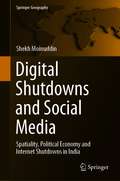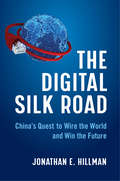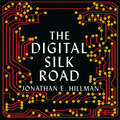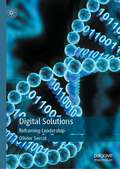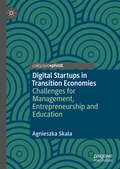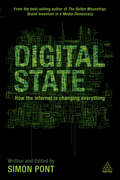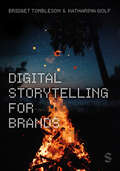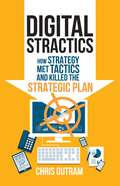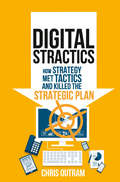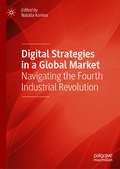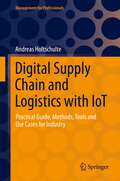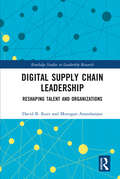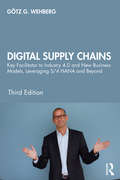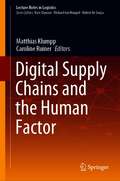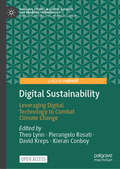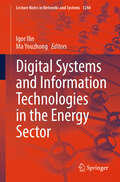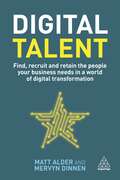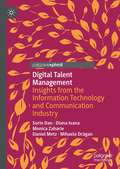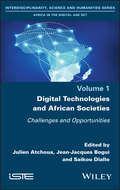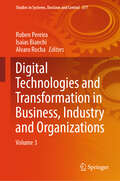- Table View
- List View
Digital Shutdowns and Social Media: Spatiality, Political Economy and Internet Shutdowns in India (Springer Geography)
by Shekh MoinuddinThis book offers a spatial insights on the social mediasphere in the context of digital shutdowns and reflects the dimensions of political economy and of social media in general. Internet shutdowns have been found to be more prevalent in developing countries than in developed countries, with India leading in Internet shutdowns in the world. Internet shutdowns have occurred in India for several reasons, mainly to hinder the spreading of information through social media – this is discussed in detail along with political motives behind this and how this can conflict with government policies, such as the flagship program “Digital India” which is ostensibly meant to improve the infrastructure and expansion of digital information throughout the country. This book suggests new dimensions in the digital spatiality. Furthermore, the digital space is defined and discussed, including its role and how this might be reflected in concepts around spatiality and spaces. More concretely, the book considers the following questions: How is social media reflected in spatial sciences? How does the space differ from more tangible spaces, such as the hydrosphere or atmosphere? How do (computer/mobile phone) screens behave as a space/place in the context of behavioural sciences? How is this reflected in what is shaping and reshaping the spatiality of digital gadgets? Do digital gadgets change the socialization process that’s often considered a path towards how we develop in society? How do internet shutdowns affect the political economy and what patterns can be seen in how individuals, companies and the internet industry in particular react to these shutdowns in India?
The Digital Silk Road: China's Quest to Wire the World and Win the Future
by Jonathan E. HillmanAn expert on China’s global infrastructure expansion provides an urgent look at the battle to connect and control tomorrow’s networks.From the ocean floor to outer space, China’s Digital Silk Road aims to wire the world and rewrite the global order. Taking readers on a journey inside China’s surveillance state, rural America, and Africa’s megacities, Jonathan Hillman reveals what China’s expanding digital footprint looks like on the ground and explores the economic and strategic consequences of a future in which all routers lead to Beijing.If China becomes the world’s chief network operator, it could reap a commercial and strategic windfall, including many advantages currently enjoyed by the United States. It could reshape global flows of data, finance, and communications to reflect its interests. It could possess an unrivaled understanding of market movements, the deliberations of foreign competitors, and the lives of countless individuals enmeshed in its networks. However, China’s digital dominance is not yet assured. Beijing remains vulnerable in several key dimensions, the United States and its allies have an opportunity to offer better alternatives, and the rest of the world has a voice. But winning the battle for tomorrow’s networks will require the United States to innovate and take greater risks in emerging markets. Networks create large winners, and this is a contest America cannot afford to lose.
The Digital Silk Road: China's Quest to Wire the World and Win the Future
by Jonathan E. HillmanIts vast infrastructure projects now extend from the ocean floor to outer space, and from Africa's megacities into rural America. China is wiring the world, and, in doing so, rewriting the global order.As things stand, the rest of the world still has a choice. But the battle for tomorrow will require America and its allies to take daring risks in uncertain political terrain. Unchecked, China will reshape global flows of data to reflect its interests. It willdevelop an unrivalled understanding of market movements, the deliberations of foreign competitors, and the lives of countless individuals enmeshed in its systems. Networks create large winners, and this is one contest that democracies can't afford to lose.Taking readers on a global tour of these emerging battlefields, Jonathan Hillman reveals what China's digital footprint looks like on the ground, and explores the dangers of a world in which all routers lead to Beijing.
Digital Solutions: Reframing Leadership
by Olivier SerratThis book acts as a valuable quick-access resource on the challenges and opportunities that the digital age presents to organizational leadership. Balanced, comprehensive, and thought-provoking, the book will be useful to professionals and practitioners. The book broadly follows a macro, meso, and micro approach to argumentation and is best read from beginning to end. The book synopsizes the historical context of technological revolutions and reflects on first-order results from enhanced use of information and communication technology in organizations; considers second-level impacts from information and communication technology on economy, society, work, and the very act of organizing; maps out core concepts of agility and principles that leaders should honor to exploit agility in newfound workforce ecosystems; showcases emerging leadership behaviors and mindsets; and specifies the good practice needed to plan and lead digital strategies. The book invites reference to the author's popular Knowledge Solutions: Tools, Methods, and Approaches to Drive Organizational Performance (2017) and the more recent Leading Solutions: Essays in Business Psychology (2021), which it both rests on and extends.
Digital Sport Marketing: Concepts, Cases and Conversations
by Alan Seymour Paul BlakeyDigital sport marketing is a new, dynamic and rapidly evolving area that is having a profound impact on contemporary sport business. This is the only textbook to introduce core principles and best practice in digital sports marketing, focusing on key issues, emerging topics and practical techniques. The book surveys the new international digital landscape in sport business and explains how to apply digital marketing across key areas from fan engagement and public relations to strategic communication and branding. Every chapter includes discussion of key concepts, an in-depth case study, and an in-depth conversation with a leading industry practitioner that demonstrates how digital marketing works in the real world. Full of useful features, this is an essential textbook for any sport marketing, sport management, sport business or sport development course.
Digital Startups in Transition Economies: Challenges for Management, Entrepreneurship and Education
by Agnieszka SkalaThis book responds to the growing demand for a scientific approach to the concept of startups, which are a manifestation of the digital revolution and an innovation-driven economy. With a focus on digital enterprises, the author presents empirical research carried out over 4 years in collaboration with the Startup Poland Foundation, and provides a developed universal definition of a startup. This book highlights the necessity of a clear definition, in order for startups to be treated as a permanent economic phenomenon, rather than a temporary whim. Addressing the crucial need for an effective startup management methodology and more education on this form of entrepreneurship, Digital Startups in Transition Economies offers guidance for those researching entrepreneurship and innovation, as well as entrepreneurs, public institutions, startup accelerators and technology transfer centres.
Digital State: The Story of Minnesota's Computing Industry
by Thomas J. MisaAccounts of the early events of the computing industry—the Turing machine, the massive Colossus, the ENIAC computer—are well-told tales, and equally well known is the later emergence of Silicon Valley and the rise of the personal computer. Yet there is an extraordinary untold middle history—with deep roots in Minnesota. From the end of World War II through the 1970s, Minnesota was home to the first computing-centered industrial district in the world.Drawing on rare archival documents, photographs, and a wealth of oral histories, Digital State unveils the remarkable story of computer development in the heartland after World War II. These decades found corporations—concentrated in large part in Minnesota—designing state-of-the-art mainframe technologies, revolutionizing new methods of magnetic data storage, and, for the first time, truly integrating software and hardware into valuable products for the American government and public. Minnesota-based companies such as Engineering Research Associates, Univac, Control Data, Cray Research, Honeywell, and IBM Rochester were major international players and together formed an unrivaled epicenter advancing digital technologies. These companies not only brought vibrant economic growth to Minnesota, they nurtured the state&’s present-day medical device and software industries and possibly even tomorrow&’s nanotechnology.Thomas J. Misa&’s groundbreaking history shows how Minnesota recognized and embraced the coming information age through its leading-edge companies, its workforce, and its prominent institutions. Digital State reveals the inner workings of the birth of the digital age in Minnesota and what we can learn from this era of sustained innovation.
Digital State
by Simon PontWhat is the Digital State? What is our Digital State of Mind? What does this Digital State mean for brands and for businesses? Big data, new distribution platforms, content collaboration, geo-targeting, crowdsourcing, viral marketing, mobile apps - the technological revolution has transformed the way society communicates and understands itself, and unleashed a whirlwind of new possibilities for marketers, as well as new risks. Mirroring the 'collaborative play space' Tim Berners-Lee first envisaged for the internet, Digital State brings together Simon Pont and 13 thought-leaders drawn from the worlds of advertising, marketing, media, publishing, law, finance and more, to explore what the digital age means for us as individuals, and the implications for the brands seeking to engage with us. Edited and part-written by Simon Pont, Digital State explores the possibilities and pitfalls of our digital age, an age where people can be brought together and new opportunities explored like never before.
Digital Stock Photography: How to Shoot and Sell
by Michal HeronThis volume details how to create salable digital stock photos, covering style and the process of shooting, preparation, and editing and post-production. Other chapters discuss running a business, marketing, finding an agency, negotiating prices, copyright, and model releases and business forms, and one chapter contains 25 stock assignments and details on each. The volume is based on the third edition of How to Shoot Stock Photos That Sell, and some information has been revised and adapted. Other sections are new. Heron is a freelance photographer and the author of other books on the subject. Annotation ©2008 Book News, Inc., Portland, OR (booknews.com)
Digital Storytelling for Brands
by Bridget Tombleson Katharina WolfDigital storytelling for brands has become a non-negotiable skill in the 21st century, due to the need to connect and communicate with diverse audiences across multiple channels and platforms. The ability to understand narrative(s) is now a prerequisite for many business, communication, marketing and public relations professionals, as well as content creators and journalists. This book teaches essential skills in deconstructing the traditional narrative and how to adapt narrative to fit contemporary platforms. Co-creative methods are emphasised and provide readers with a theoretical underpinning of participatory culture, and narrative. For the first time ever, this book brings together extant arts and humanities-based models with business theory. It provides learners with a clear understanding of the creative and persuasive form of narrative within a digital context, whilst building brand. Contemporary case studies highlight challenges faced in the digital world, including implications for reputation management, considerations associated with mis- and disinformation and the crucial role of the collective narrative. A key principle guiding this book is: ‘the more digital we become, the more we crave to feel human’ and it is this very space where digital storytelling can cut through the (digital) noise to provide an authentic connection. Bridget Tombleson is an academic at Curtin University, Perth, Western Australia, with more than twenty years’ experience in public relations and the communication industry. Katharina Wolf is an Associate Professor at Curtin University in Perth, Western Australia, and Lead of the Faculty of Business and Law’s public relations program.
Digital Storytelling for Brands
by Bridget Tombleson Katharina WolfDigital storytelling for brands has become a non-negotiable skill in the 21st century, due to the need to connect and communicate with diverse audiences across multiple channels and platforms. The ability to understand narrative(s) is now a prerequisite for many business, communication, marketing and public relations professionals, as well as content creators and journalists. This book teaches essential skills in deconstructing the traditional narrative and how to adapt narrative to fit contemporary platforms. Co-creative methods are emphasised and provide readers with a theoretical underpinning of participatory culture, and narrative. For the first time ever, this book brings together extant arts and humanities-based models with business theory. It provides learners with a clear understanding of the creative and persuasive form of narrative within a digital context, whilst building brand. Contemporary case studies highlight challenges faced in the digital world, including implications for reputation management, considerations associated with mis- and disinformation and the crucial role of the collective narrative. A key principle guiding this book is: ‘the more digital we become, the more we crave to feel human’ and it is this very space where digital storytelling can cut through the (digital) noise to provide an authentic connection. Bridget Tombleson is an academic at Curtin University, Perth, Western Australia, with more than twenty years’ experience in public relations and the communication industry. Katharina Wolf is an Associate Professor at Curtin University in Perth, Western Australia, and Lead of the Faculty of Business and Law’s public relations program.
Digital Stractics: How Strategy Met Tactics And Killed The Strategic Plan
by Chris OutramIn the world of digital business, the line between strategy and tactics is blurring. Traditionally large companies would adopt strategic frameworks which planned over three- to five-year timescales, while most digital start-ups had little interest in comprehensive and rigorous strategic processes and simply set themselves vision and worked out how to get there along the way. In today's digital economy even large companies are finding that their planning horizons are being measured in months rather than years or quarters (if not yet in the weeks or even days of startups). On the other hand, investors are less swayed by the excitement of 'digital' and expect harder and more rigorous medium term planning from start-ups. As a result, while the empirical process of learning by doing is becoming part of traditional companies' strategy processes, digital pure plays are no longer just making it up as they go along, but actively learning and changing as they go along. In short: on the battlefield of online commerce, strategy blends with tactics. Indeed, the distinction between pure play and hybrid is increasingly redundant as more holistic business models begin to emerge. Digital Stractics captures the experience and insights of some 60 entrepreneurs, CEOs and chairmen of both pure plays and hybrids to formulate frameworks within which both pure plays and hybrids can shape their strategy and business models. As timescales between 'plan' and 'do' collapse strategy and tactics have to blend. The world of STRACTICS is upon us.
Digital Stractics: How Strategy Met Tactics and Killed the Strategic Plan
by Chris OutramIn the world of digital business, the line between strategy and tactics is blurring. Traditionally large companies would adopt strategic frameworks which planned over three- to five-year timescales, while most digital start-ups had little interest in comprehensive and rigorous strategic processes and simply set themselves vision and worked out how to get there along the way. In today's digital economy even large companies are finding that their planning horizons are being measured in months rather than years or quarters (if not yet in the weeks or even days of startups). On the other hand, investors are less swayed by the excitement of 'digital' and expect harder and more rigorous medium term planning from start-ups.As a result, while the empirical process of learning by doing is becoming part of traditional companies' strategy processes, digital pure plays are no longer just making it up as they go along, but actively learning and changing as they go along. In short: on the battlefield of online commerce, strategy blends with tactics. Indeed, the distinction between pure play and hybrid is increasingly redundant as more holistic business models begin to emerge. Digital Stractics captures the experience and insights of some 60 entrepreneurs, CEOs and chairmen of both pure plays and hybrids to formulate frameworks within which both pure plays and hybrids can shape their strategy and business models. As timescales between 'plan' and 'do' collapse strategy and tactics have to blend. The world of STRACTICS is upon us.
Digital Strategies in a Global Market: Navigating the Fourth Industrial Revolution
by Natalia KoninaThis book examines the impact of the Fourth Industrial Revolution on business strategy, marketing, management, sustainability innovation, and various kinds of industry. It provides a broad overview of ways that organisations have sought to develop a digital strategy, and explores the challenges and opportunities posed by a rapidly transforming digital world. It draws on European and Russian case studies, with chapters addressing smart cities, corporate governance, the digital single market, and agrobusiness. This book will be of interest to academics and practitioners in management and economics, who are interested in digital strategies performance in global markets.
Digital Supply Chain and Logistics with IoT: Practical Guide, Methods, Tools and Use Cases for Industry (Management for Professionals)
by Andreas HoltschulteThe concepts for Industry 4.0 and the Industrial Internet of Things (IIoT) will fundamentally change supply chains, production processes and industries. Intelligent technologies such as IoT, edge and cloud computing, big data, artificial intelligence and digital assistance systems are drivers of this change. This book provides a comprehensive overview of IoT use cases with illustrative practical examples of how digitization or innovation projects can be successfully implemented. It takes into consideration that processes are getting more flexible and efficient, and new digital technologies allow seamless, location-independent communication in near real time between things, processes and people through the digitization of physical objects and processes. Considering these changes, the book provides a guideline on how companies should position themselves for the future with industrial IoT in order to still play a decisive role in the industry in a few years' time. The book is aimed at both decision-makers and practitioners who, on the one hand, recognize the opportunities and possibilities for their company and, on the other hand, want to learn how to use the appropriate technologies. With this in mind it will be valuable for entrepreneurs, managers, architects and also developers in the field of Industry 4.0.
Digital Supply Chain Leadership: Reshaping Talent and Organizations (Routledge Studies in Leadership Research)
by David Kurz Murugan AnandarajanStrong leadership is necessary to drive the transformational change required to build and apply digital capabilities across organizations. Digital transformation in the supply chain is a leadership problem first and foremost. This book draws out some of the key digital business strategies supply chain leaders must become familiar with as they take on the responsibilities of leading transformations within their firms.The central rationale of the book is to establish a clear business case for the performance shifts and opportunities of the Digital Supply Chain. The benefits of a digital supply chain for firms can be summarized as uniquely reducing the amount of trade-off between costs and customer satisfaction. The challenges, complexity, and management involved in transforming to a digital supply chain have slowed many firms in their implementation. The key to unlocking this value and advantage is a new, robust, and digitally aware supply chain leadership mindset. It will provide readers with a practical Digital Supply Chain Leadership Road Map that will accelerate actions in technology, analytics, talent and business models. The road map to digital transformation will step the reader through these critical dimensions and illustrate how they can support their own organizational transformation by developing greater levels of maturity. This book will be most valued by supply chain leaders in medium to large scale organizations, as well as consultants and academics interested in digital business and supply chain transformation. The book will also be valuable for students studying digital transformation, supply chain, and operations.
Digital Supply Chain Leadership: Reshaping Talent and Organizations (Routledge Studies in Leadership Research)
by David B. Kurz Murugan AnandarajanStrong leadership is necessary to drive the transformational change required to build and apply digital capabilities across organizations. Digital transformation in the supply chain is a leadership problem first and foremost. This book draws out some of the key digital business strategies supply chain leaders must become familiar with as they take on the responsibilities of leading transformations within their firms. The central rationale of the book is to establish a clear business case for the performance shifts and opportunities of the Digital Supply Chain. The benefits of a digital supply chain for firms can be summarized as uniquely reducing the amount of trade-off between costs and customer satisfaction. The challenges, complexity, and management involved in transforming to a digital supply chain have slowed many firms in their implementation. The key to unlocking this value and advantage is a new, robust, and digitally aware supply chain leadership mindset. It will provide readers with a practical Digital Supply Chain Leadership Road Map that will accelerate actions in technology, analytics, talent and business models. The road map to digital transformation will step the reader through these critical dimensions and illustrate how they can support their own organizational transformation by developing greater levels of maturity. This book will be most valued by supply chain leaders in medium to large scale organizations, as well as consultants and academics interested in digital business and supply chain transformation. The book will also be valuable for students studying digital transformation, supply chain, and operations.
Digital Supply Chains: Key Facilitator to Industry 4.0 and New Business Models, Leveraging S/4 HANA and Beyond
by Götz G. WehbergThis book provides a practical guide to digital supply chain modelling, demonstrating an agile approach to how such models can be applied to any manufacturing company to build competitive advantage, facilitate new business models and drive towards Industry 4.0. The agile approach of the book provides an attractive alternative to the conventional country-by-country deployment of S/4 HANA and other relevant technologies. This book contains the expertise Gotz G. Wehberg has amassed over 20 years as a senior partner in a leading consulting company, working across industries and with globally recognized clients, advising on digitization. In it, he explains the scientific roots of digital supply chain management such as holism, cybernetics, self-organization and evolutionary theory to inform a deep understanding that can drive a supremely innovative strategy for Industry 4.0. Beyond strategy, Wehberg introduces the practical tools and technologies used in supply chain modelling, for example, sensors, big data, artificial intelligence and the Internet of Things, as well as a reference framework that categorizes the technologies, together with the latest concepts and tools, such as DDMRP, predictive S&OP, pattern recognition, autonomous logistics and Lean. This framework supports decision making for developing supply chains in an end-to-end and cross-functional fashion, providing clear guidance for executives and managers on how to design supply chains for the future.
Digital Supply Chains and the Human Factor (Lecture Notes in Logistics)
by Matthias Klumpp Caroline RuinerThis book covers topics such as digitalization of production, operations, logistics and supply chains leading to new requirements for human capabilities and collaboration. The content is relevant for research as well as industry as digitalization is shaping all value chain processes anew. A special focus is directed towards an interdisciplinary perspective, including management science, economics, sociology, work science, computer science and psychology. In order to foster the dialogue between business practice and academics as well as university teaching and research, this contributed book is addressing academic as well as professional business views on digitalization.
Digital Sustainability: Leveraging Digital Technology to Combat Climate Change (Palgrave Studies in Digital Business & Enabling Technologies)
by Kieran Conboy David Kreps Theo Lynn Pierangelo RosatiDigitalisation and environmental sustainability are two of the megatrends impacting industry and society. This open access Pivot is a timely exploration of some of the challenges and prospects related to digital sustainability from two main perspectives: how digital technologies can be used and maintained in a way that is environmentally sustainable over the long term (greening of digital technologies), and how digital technologies can be used to address climate change and improve environmental and sustainability outcomes (greening by digital technologies). The chapters included in this book are designed to provide some key definitions and concepts related to digital sustainability and its evolution, and more detailed insights on some of the key priority areas outlined in the European Green Deal, namely energy, mobility, buildings, food and the circular economy. A critical review of these topics will summarise and present different perspectives that challenge old assumptions and highlight emerging trends and possibilities for digital sustainability. Industry and society face significant challenges in the twin transition to digital and green transformation, not least of which is the need to balance investment in digital technologies with environmental sustainability. This open-access book can serve as a primer for scholars, policymakers, and enterprise decision-makers, providing insights on navigating innovation ecosystems to support both green and digital objectives.
Digital Systems and Information Technologies in the Energy Sector (Lecture Notes in Networks and Systems #1244)
by Igor Ilin Ma YouzhongDigital transformation and energy transition are undoubtedly the key trends of the last decade that are fundamentally changing the way countries, regions and the global community conduct their economic activities. At first glance, these are phenomena of completely different nature. The editors and authors of the book offer a closer look at the specifics of the development of each trend, the nature of their interdependence, analyze the possibilities of coexistence, and determine the potential effects of such technological symbiosis. The book is characterized by an original, interdisciplinary statement of the problem: description of various aspects of effective interaction between elements of energy and information-technology/digital infrastructures that jointly ensure information needs and compliance with energy efficiency requirements of the modern economy. At the same time, attention is paid to each technological trend separately, as well as to the possibilities of interaction between technological capabilities of energy and digital. International author teams of professionals in different fields offer an interesting perspective on certain aspects of modern technological development of various industries. The book will be of interest to both experienced researchers, undergraduate and graduate students, and practitioners, both energy and IT specialists and even mathematicians.
Digital Talent: Find, Recruit and Retain the People your Business Needs in a World of Digital Transformation
by Matt Alder Mervyn DinnenIn a disrupted and technology-enabled world of work, HR professionals' ability to attract, recruit and retain people with digital skills can be the difference between business success and failure.Digital Talent equips HR with the tools they need to assess what these critical skills are, how to attract the people who have them, keep these people engaged, productive and performing to the best of their abilities. It also provides crucial guidance on how to continuously develop employees, including leaders, to ensure that the organization has the skills it needs both for today and the future.This book provides advice on how to create new processes that are fit for purpose in the age of digital transformation, build inclusion when digital culture is becoming more prominent and use digital abilities effectively to maximise productivity while maintaining employee wellbeing. Digital Talent is the book on talent that HR , talent acquisition professionals and business leaders need to make sure that their people, and the business as a whole, stay ahead of the competition.
Digital Talent Management: Insights from the Information Technology and Communication Industry
by Sorin Dan Diana Ivana Monica Zaharie Daniel Metz Mihaela DrăganThis book highlights the importance of talent management practices in recruiting, developing and retaining talented professionals in the digital and IT&C industry. It unpacks the distinctive characteristics of ‘digital talent’ represented by a wide spectrum of professionals and managers with digital abilities, competencies and skills who add considerable value to organizations and industries worldwide. It shows that despite digital talent’s increased variety and significant contribution to digital transformation processes, much of the existing human resource and talent management research and practice fail to account for their distinctiveness. This book calls for the need for a new kind of talent management, referred to as ‘digital talent management’ (DTM) that is applicable to digital talent and decidedly integrates digital talent’s distinctive characteristics into talent management strategies and practices in a human-centered manner. Drawing upon existing, yet disconnected, streams of literature and empirical evidence derived from the information technology and communication (IT&C) industry, this book defines digital talent and delineates strategies to attract, develop and retain them for an uncertain and renewed future.
Digital Technologies and African Societies: Challenges and Opportunities
by Julien Atchoua Jean-Jacques Bogui Saikou DialloThe integration and use of information and communication technologies (ICT) in African countries is increasingly observable in various sectors of activity (banking, education, trade, etc.) despite a digital divide still relevant. ICT has become a major sector of the recent growth of a new informal economy in African cities (Chéneau-Loquay, 2008). This question has been at the heart of various international meetings. An overall positive and even utopian momentum is generally heard about the contribution of digital technologies to the development of African states. The adoption or appropriation of digital technologies by Africans is presented in many speeches by politicians or institutions involved in the field of cooperation and international development as an important issue for the development of this continent. These different considerations give rise to reflections on the following themes. - Social Media and Public Space in Africa - Challenges of the digital economy in Africa - ICT and modernization of higher education in Africa
Digital Technologies and Transformation in Business, Industry and Organizations: Volume 3 (Studies in Systems, Decision and Control #577)
by Ruben Pereira Isaias Bianchi Alvaro RochaThis book covers research methods such as Systematic Literature Review (SLR) or Multifocal Literature Review (MLR), case studies, experiments, surveys, and Design Science Research using quantitative and qualitative approaches. This proposal is the third volume of the already edited and published book “Digital Technologies and Transformation in Business, Industry and Organizations.” Given the nature of this book proposal, linked with some Masters, and the faster pace of digital technologies evolution, the new version will have an entire new content with new cases and insights regarding the development and implementation of the most interesting digital technologies. Digital transformation marks a rethinking of how an organization uses technology, people, and processes in pursuit of new business models and new revenue streams, driven by changes in customer expectations around products and services. For many enterprises that build traditional goods, this means building digital products, such as a mobile application or an e-commerce platform. To do so, they must use and integrate digital technologies. The pace of change is increasing. Organizations need to adapt or risk disappearing under innovators entrance in the market. With new digital technologies growing in an exponential rate in the last few decades, organizations are facing even more complex contexts. Managers are now pressed to take efficient decisions. This book provides a reference manual to assist professionals and academics on further insights regarding: the impact of digital technologies in business, how to implement digital technologies, solutions for specific digital technologies barriers, and much more.
